Lyons W.C. (ed.). Standard handbook of petroleum and natural gas engineering.2001- Volume 1
Подождите немного. Документ загружается.

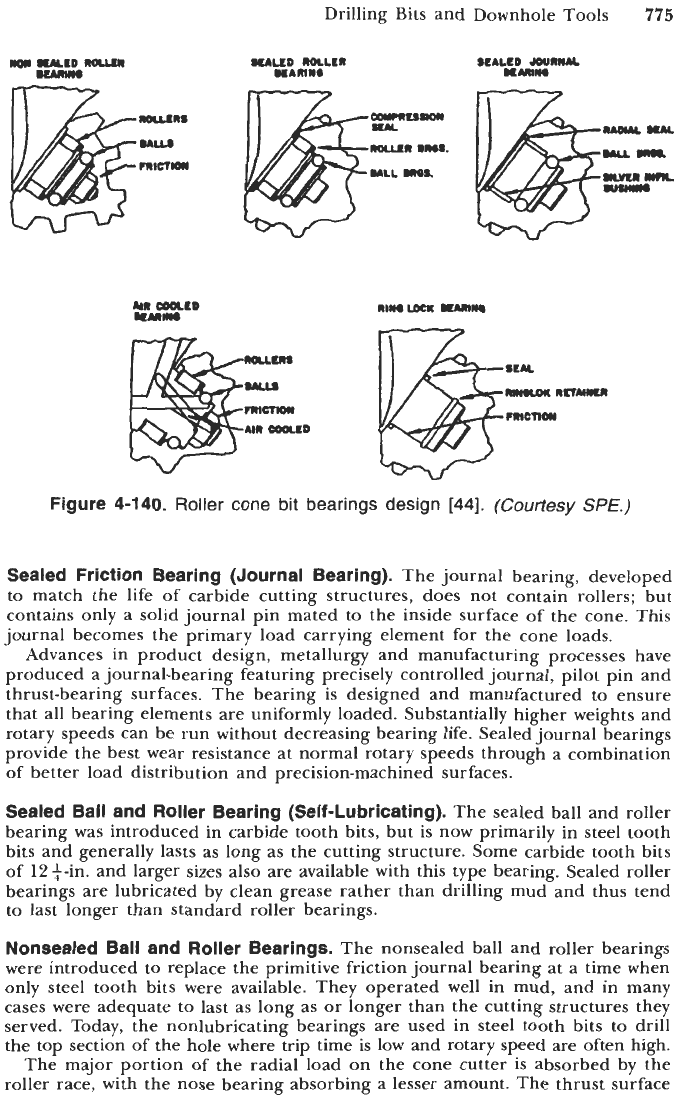
Drilling Bits and Downhole Tools
775
Figure
4-140. Roller cone bit bearings design
[44].
(Courtesy
SPE.)
Sealed Friction Bearing (Journal Bearing).
The journal bearing, developed
to match the life of carbide cutting structures, does not contain rollers; but
contains only a solid journal pin mated to the inside surface of the cone. This
journal becomes the primary load carrying element for the cone loads.
Advances in product design, metallurgy and manufacturing processes have
produced a journal-bearing featuring precisely controlled journal, pilot pin and
thrust-bearing surfaces. The bearing
is
designed and manufactured to ensure
that all bearing elements are uniformly loaded. Substantially higher weights and
rotary speeds can be run without decreasing bearing life. Sealed journal bearings
provide the best wear resistance at normal rotary speeds through a combination
of better load distribution and precision-machined surfaces.
Sealed Ball and Roller Bearing (Self-Lubricating).
The sealed ball and roller
bearing was introduced in carbide tooth bits, but is now primarily in steel tooth
bits and generally lasts as long as the cutting structure. Some carbide tooth bits
of
12
$-in. and larger sizes also are available with this type bearing. Sealed roller
bearings are lubricated by clean grease rather than drilling mud and thus tend
to last longer than standard roller bearings.
Nonsealed Ball and Roller Bearings.
The nonsealed ball and roller bearings
were introduced to replace the primitive friction journal bearing at a time when
only steel tooth bits were available. They operated well in mud, and in many
cases were adequate to last as long as or longer than the cutting structures they
served. Today, the nonlubricating bearings are used in steel tooth bits to drill
the top section of the hole where trip time is low and rotary speed are often high.
The major portion of the radial load on the cone cutter is absorbed by the
roller race, with the nose bearing absorbing a lesser amount. The thrust surface
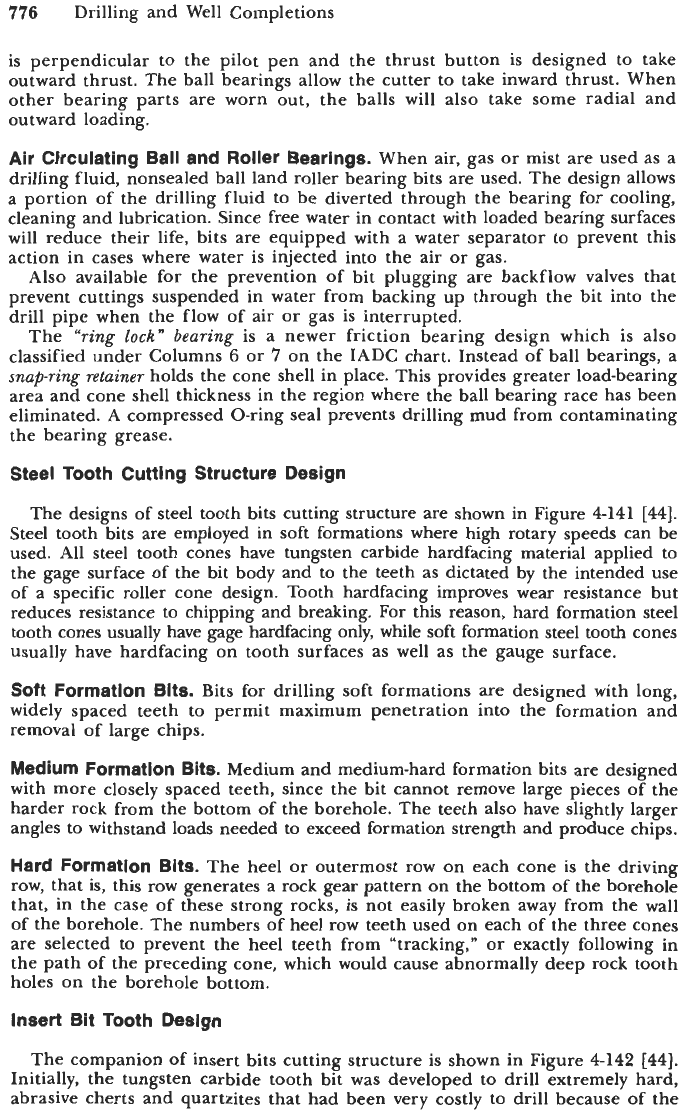
776
Drilling and Well Completions
is perpendicular to the pilot pen and the thrust button is designed to take
outward thrust. The ball bearings allow the cutter to take inward thrust. When
other bearing parts are worn out, the balls will also take some radial and
outward loading.
Air Circulating Ball and Roller Bearings.
When air, gas
or
mist are used as
a
drilling fluid, nonsealed ball land roller bearing bits are used. The design allows
a portion of the drilling fluid to be diverted through the bearing for cooling,
cleaning and lubrication. Since free water in contact with loaded bearing surfaces
will reduce their life, bits are equipped with a water separator to prevent this
action in cases where water is injected into the air
or
gas.
Also available for the prevention of bit plugging are backflow valves that
prevent cuttings suspended in water from backing up through the bit into the
drill pipe when the flow of air or gas is interrupted.
The
“ring
lock”
bearing
is a newer friction bearing design which is also
classified under Columns
6
or
7
on the
IADC
chart. Instead of ball bearings, a
snapring
retainer
holds the cone shell in place. This provides greater load-bearing
area and cone shell thickness in the region where the ball bearing race has been
eliminated. A compressed O-ring seal prevents drilling mud from contaminating
the bearing grease.
Steel Tooth Cutting Structure Design
The designs of steel tooth bits cutting structure are shown in Figure
4-141 [44].
Steel tooth bits are employed in soft formations where high rotary speeds can be
used. All steel tooth cones have tungsten carbide hardfacing material applied to
the gage surface of the bit body and to the teeth as dictated by the intended use
of a specific roller cone design. Tooth hardfacing improves wear resistance but
reduces resistance to chipping and breaking, For this reason, hard formation steel
tooth cones usually have gage hardfacing only, while soft formation steel tooth cones
usually have hardfacing on tooth surfaces as well as the gauge surface.
Soft Formation Bits.
Bits for drilling soft formations are designed with long,
widely spaced teeth to permit maximum penetration into the formation and
removal of large chips.
Medium Formation Bits.
Medium and medium-hard formation bits
are
designed
with more closely spaced teeth, since the bit cannot remove large pieces of the
harder rock from the bottom of the borehole. The teeth also have slightly larger
angles to withstand loads needed to exceed formation strength and produce chips.
Hard Formation
Blts.
The heel
or
outermost row
on
each cone is the driving
row, that is, this
row
generates a rock gear pattern on the bottom of
the
borehole
that, in the case of these strong rocks,
is
not easily broken away from the wall
of the borehole. The numbers of heel row teeth used on each of the three cones
are selected to prevent the heel teeth from “tracking,”
or
exactly following in
the path of the preceding cone, which would cause abnormally deep rock tooth
holes on the borehole bottom.
Insert
Bit Tooth
Design
The companion of insert bits cutting structure is shown in Figure
4142
[44].
Initially, the tungsten carbide tooth bit was developed to drill extremely hard,
abrasive cherts and quartzites that had been very costly to drill because of the

Drilling Bits and Downhole Tools
777
IADC CODE 11 1 IADC CODE 121 IADC CODE 131 IADC CODE 21 1 IADC CODE 31 1
Tooth
Profile
IADC CODE 11 1
IADC CODE 131
IADC CODE 31 1
Figure
4-141.
Steel tooth bit cutting structure design
[44].
(Courtesy
SPE.)
relatively short life of steel tooth bits in such formations. In this type of bit,
tungsten carbide and forged alloy steel are combined to produce a cutting
structure having a high resistance to abrasive wear and extremely high resistance
to compressive loads. Compacts of cylindrical tungsten carbide with various
shaped ends are pressed into precisely machined holes in case-hardened alloy
steel cones to form the teeth. The grain size and cobalt content of tungsten
carbide inserts is varied to alter the impact toughness and abrasion resistance
of the cutter. Softer formation inserts, which are usually run in less abrasive
rocks at higher rotary speeds, require increased toughness to resist breakage of
the relatively long cutters.
A
cobalt content of
16%
and average grain size of
6
pm is typical for such inserts. Hard formation inserts are generally run in more
abrasive rocks at higher
WOB
levels. Hard formation inserts have a more
breakage-resistant geometry
so
abrasion resistance becomes the most important
factor. Thus the cobalt content is reduced to about
10%
and the average grain
size is approximately
4
pm.
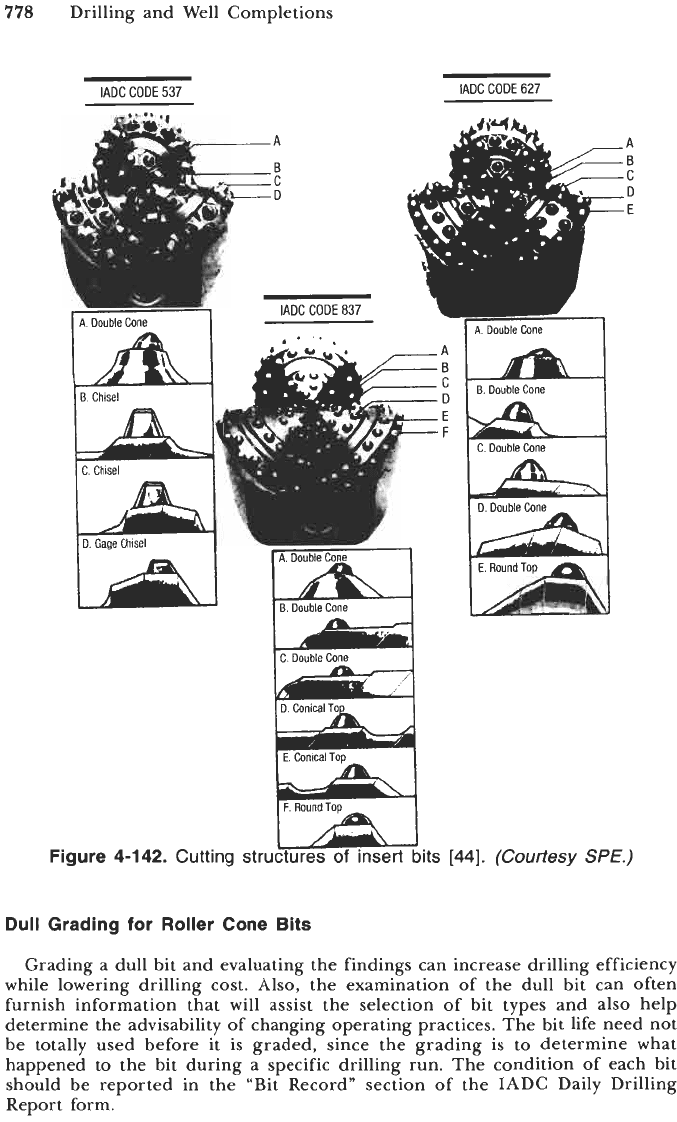
778
Drilling and Well Completions
IADC CODE
627
IADC CODE
537
Ik4mL-J
Figure
4-142.
Cutting structures
of
insert
bits
[44].
(Courtesy
SPE.)
Dull Grading for Roller Cone
Bits
Grading a dull bit and evaluating the findings can increase drilling efficiency
while lowering drilling cost.
Also,
the examination of the dull bit can often
furnish information that will assist the selection of bit types and also help
determine the advisability
of
changing operating practices. The bit life need not
be totally used before it is graded, since the grading is to determine what
happened to the bit during a specific drilling run. The condition
of
each bit
should be reported in the “Bit Record” section of the IADC Daily Drilling
Report form.
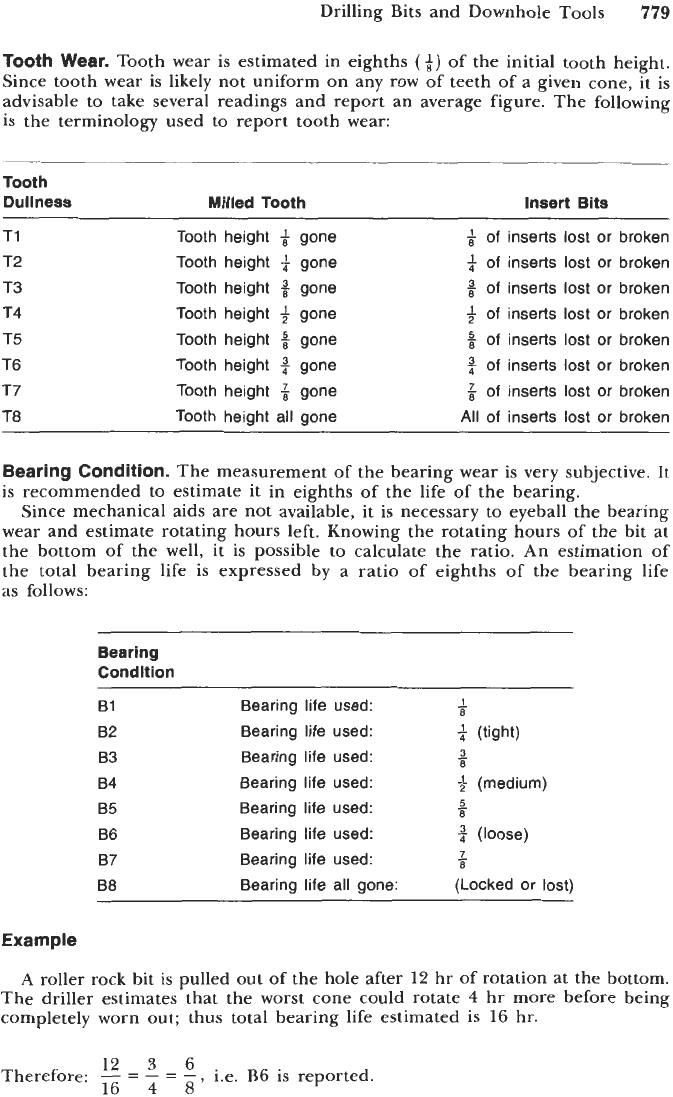
Drilling Bits and Downhole Tools
779
Tooth Wear.
Tooth wear is estimated in eighths
(4)
of the initial tooth height.
Since tooth wear is likely not uniform on any row of teeth of a given cone, it is
advisable to take several readings and report an average figure. The following
is
the terminology used to report tooth wear:
Tooth
Dullness Milled Tooth Insert Bits
T1
T2
T3
T4
T5
T6
T7
T8
Tooth height gone
Tooth height
4
gone
Tooth height
2
gone
Tooth height
3
gone
Tooth height
3
gone
Tooth height
f
gone
Tooth height
g
gone
Tooth height all gone
of
inserts lost or broken
4
of inserts lost or broken
$
of inserts lost or broken
3
of
inserts lost or broken
of inserts lost or broken
a
of inserts lost or broken
g
of inserts lost or broken
All
of inserts lost or broken
Bearing Condition.
The measurement of the bearing wear is very subjective.
It
is recommended to estimate it in eighths of the life of the bearing.
Since mechanical aids are not available, it is necessary to eyeball the bearing
wear and estimate rotating hours left. Knowing the rotating hours
of
the bit at
the bottom of the well, it is possible to calculate the ratio. An estimation
of
the total bearing life is expressed by a ratio
of
eighths of the bearing life
as
follows:
Bearing
Condition
B1
82
B3
84
B5
B6
B7
88
Bearing life used:
Bearing life used:
Bearing life used:
Bearing life used:
Bearing life used:
Bearing
life
used:
Bearing life used:
Bearing
life
all gone:
-
4
(tight)
$
(medium)
3
(loose)
3
-
5
-
7
8
-
(Locked
or
lost)
Example
A
roller rock bit is pulled out
of
the hole after
12
hr of rotation at the bottom.
The driller estimates that the worst cone could rotate
4
hr more before being
completely worn out; thus total bearing life estimated is
16
hr.
12
3
6.
Therefore:
-
=
-
=
-,
1.e.
B6
is reported.
16
4
8
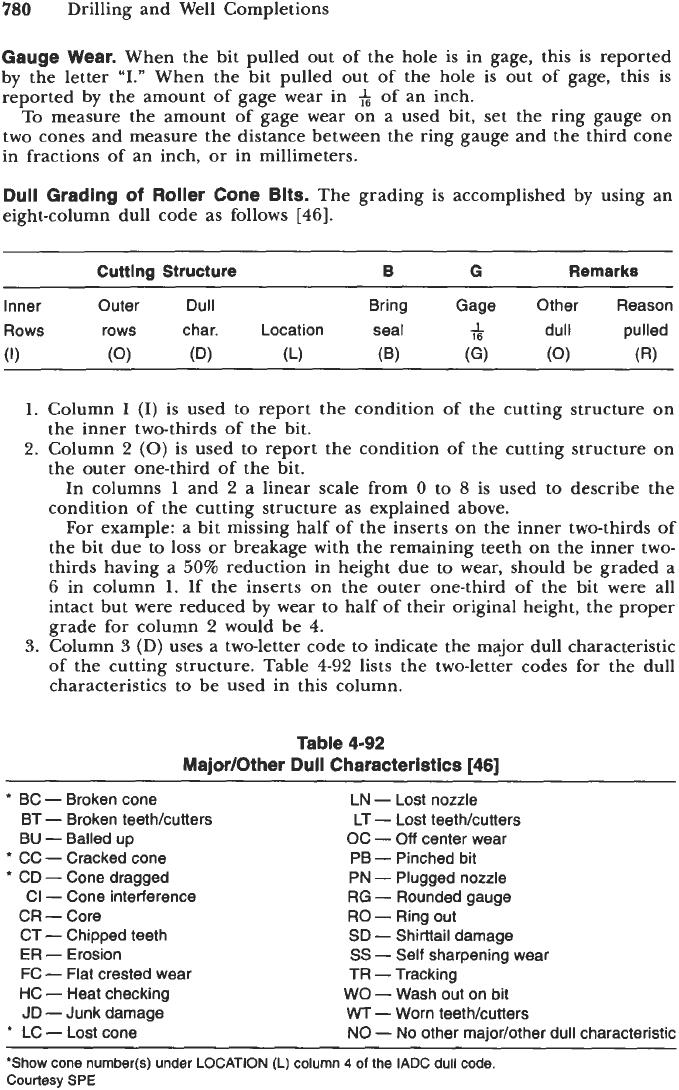
780
Drilling and Well Completions
Gauge Wear.
When the bit pulled out of the hole is in gage, this
is
reported
by the letter
"I."
When the bit pulled out
of
the hole is out
of
gage, this is
reported by the amount of gage wear in
+
of
an inch.
To measure the amount of gage wear on a used bit, set the ring gauge on
two cones and measure the distance between the ring gauge and the third cone
in fractions of an inch, or in millimeters.
Dull Grading
of
Roller Cone Bits.
The grading is accomplished by using an
eight-column dull code as follows
[46].
Cutting Structure
0
G
Remarks
Inner Outer Dull Bring Gage Other Reason
Rows
rows char. Location seal
7k
dull pulled
(1)
(0)
(D)
(L) (B) (GI
(0)
(R)
1.
Column
I
(I)
is used to report the condition of the cutting structure on
the inner two-thirds of the bit.
2.
Column
2
(0)
is used to report the condition of the cutting structure on
the outer one-third of the bit.
In columns
1
and
2
a linear scale from
0
to
8
is used to describe the
condition of the cutting structure as explained above.
For example: a bit missing half of the inserts on the inner two-thirds of
the bit due to loss or breakage with the remaining teeth on the inner two-
thirds having a
50%
reduction in height due to wear, should be graded a
6
in column
1.
If the inserts on the outer one-third of the bit were all
intact but were reduced by wear to half of their original height, the proper
grade for column
2
would be
4.
3.
Column
3
(D)
uses a two-letter code to indicate the major dull characteristic
of the cutting structure. Table
4-92
lists the two-letter codes for the dull
characteristics to be used in this column.
Table
4-92
Majorlother Dull Characteristics
[46]
BC
-
Broken cone
BT
-
Broken teethkutters
BU
-
Balled up
LN
-
Lost nozzle
LT
-
Lost teethkutters
OC
-
Off
center wear
PB
-
Pinched bit
PN
-
Plugged nozzle
CI
-
Cone interference RG-Roundedgauge
CR
-
Core
RO
-
Ring out
CT
-
Chipped teeth SD
-
Shirttail damage
ER
-
Erosion
SS
-
Self sharpening wear
FC
-
Flat crested wear
TR
-
Tracking
HC
-
Heat checking
WO
-
Wash out on bit
JD
-
Junk damage
WT
-
Worn teeth/cutters
NO
-
No
other majodother dull characteristic
*
CC
-
Cracked cone
*
CD
-
Cone dragged
LC
-
Lost cone
'Show cone
number(s)
under LOCATION
(L)
column
4
of
the IADC dull code.
Courtesy
SPE
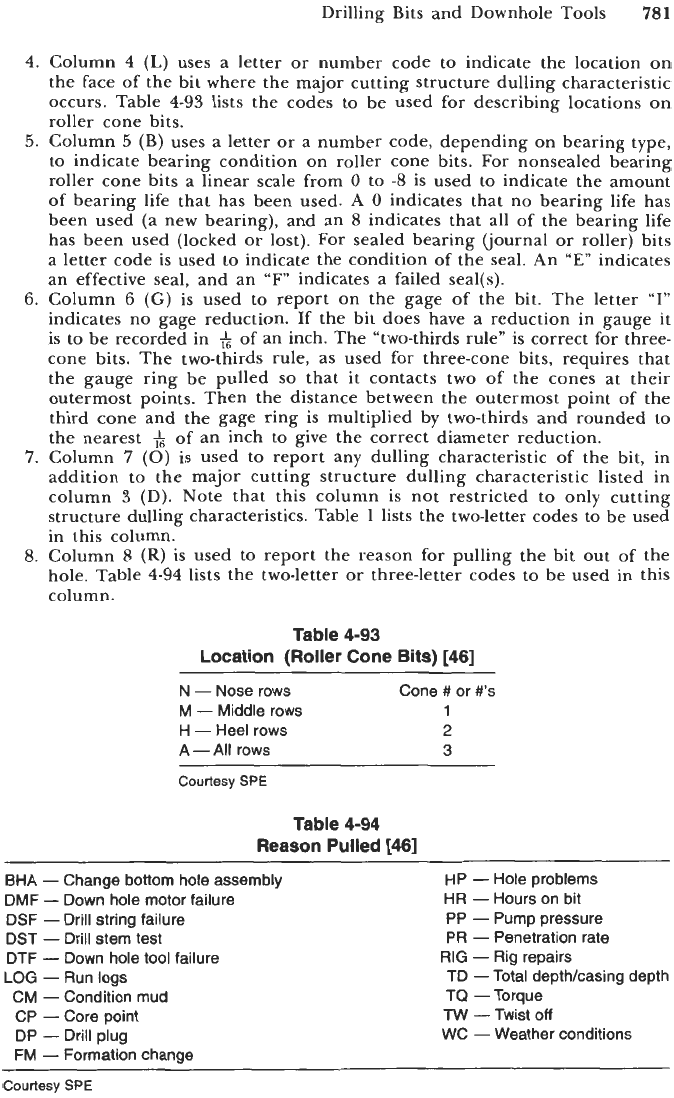
Drilling Bits and Downhole Tools
781
4.
5.
6.
7.
8.
Column
4
(L)
uses a letter or number code to indicate the location on
the face of the bit where the major cutting structure dulling characteristic
occurs. Table
4-93
lists the codes to he used for describing locations on
roller cone bits.
Column
5
(B)
uses a letter or a number code, depending on bearing type,
to indicate bearing condition on roller cone bits. For nonsealed bearing
roller cone bits a linear scale from
0
to
-8
is used to indicate the amount
of bearing life that has been used.
A
0
indicates that no bearing life has
been used (a
new
bearing), and an
8
indicates that all of the bearing life
has been used (locked or lost). For sealed bearing (journal or roller) hits
a letter code is used to indicate the condition of the seal. An
“E”
indicates
an effective seal, and an “F” indicates a failed seal(s).
Column
6
(G)
is used to report on the gage
of
the bit. The letter
“I”
indicates no gage reduction. If the bit does have a reduction in gauge it
is to be recorded in
+
of
an
inch. The “two-thirds rule” is correct for three-
cone bits.
The
two-thirds rule, as used for three-cone hits, requires that
the gauge ring be pulled
so
that it contacts two
of
the cones at their
outermost points. Then the distance between the outermost point of the
third cone and the gage ring is multiplied by two-thirds and rounded to
the nearest
&
of
an inch to give the correct diameter reduction.
Column
7
(0)
is used
to
report any dulling characteristic
of
the bit, in
addition to the major cutting structure dulling characteristic listed in
column
3
(D).
Note that this column is not restricted to only cutting
structure dulling characteristics. Table
1
lists the two-letter codes to be used
in this column.
Column
8
(R)
is used to report the reason for pulling the bit out
of
the
hole. Table
4-94
lists the two-letter or three-letter codes
to
be used in this
column.
Table
4-93
Location (Roller Cone
Bits)
[46]
N
-
Nose rows
M
-
Middle rows
1
H
-
Heel rows
2
A
-
All
rows
3
Cone
#
or
#s
Courtesy
SPE
Table
4-94
Reason Pulled
[46]
BHA
-
Change bottom hole assembly
DMF
-
Down hole motor failure
DSF
-
Drill string failure
DST
-
Drill stem test
DTF
-
Down hole tool failure
LOG
-
Run logs
CM
-
Condition mud
CP
-
Core point
DP
-
Drill plug
FM
-
Formation change
HP
-
Hole problems
HR
-
Hours on bit
PP
-
Pump pressure
PR
-
Penetration rate
RIG
-
Rig repairs
TD
-Total
depthhasing depth
TQ
-
Torque
TW
-Twist
off
WC -Weather conditions
Courtesy
SPE
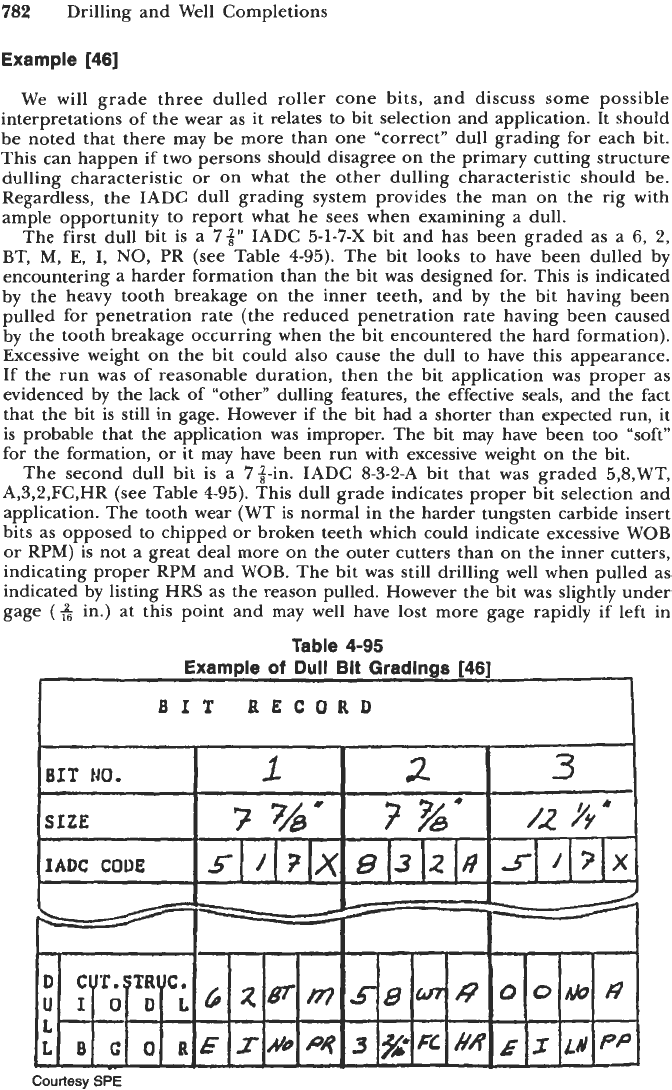
782
Drilling and Well Completions
Example
[46]
We will grade three dulled roller cone bits, and discuss some possible
interpretations of the wear as it relates to bit selection and application. It should
be noted that there may be more than one “correct” dull grading for each bit.
This can happen if two persons should disagree on the primary cutting structure
dulling characteristic or on what the other dulling characteristic should be.
Regardless, the IADC dull grading system provides the man on the rig with
ample opportunity to report what he sees when examining a dull.
The first dull bit is a
7%“
IADC 5-1-7-X bit and has been graded as a
6,
2,
BT,
M,
E,
I,
NO,
PR (see Table 4-95). The bit looks to have been dulled by
encountering a harder formation than the bit was designed for. This is indicated
by the heavy tooth breakage on the inner teeth, and by the bit having been
pulled for penetration rate (the reduced penetration rate having been caused
by the tooth breakage occurring when the bit encountered the hard formation).
Excessive weight
on
the bit could also cause the dull to have this appearance.
If the run was of reasonable duration, then the bit application was proper as
evidenced by the lack of “other” dulling features, the effective seals, and the fact
that the bit is still in gage. However
if
the bit had a shorter than expected run, it
is probable that the application was improper. The bit may have been too “soft”
for the formation, or it may have been run with excessive weight on the bit.
The second dull bit is a 72-in. IADC 8-3-2-A bit that was graded 5,8,WT,
A,3,2,FC,HR (see Table 4-95). This dull grade indicates proper bit selection and
application. The tooth wear (WT is normal in the harder tungsten carbide insert
bits as opposed to chipped or broken teeth which could indicate excessive WOB
or
RPM)
is not a great deal more on the outer cutters than on the inner cutters,
indicating proper RPM and WOB. The bit was still drilling well when pulled as
indicated by listing
HRS
as the reason pulled. However the bit was slightly under
gage
(+
in.) at this point and may well have
lost
more gage rapidly
if
left in
Table
4-95
I‘
1.’
’
!
L
’
Courtesy
SPE

Drilling Bits and Downhole Tools
783
the hole. This supports the decision to pull the bit based on the hours.
A
bearing condition of
3
on the air bearings indicates good bearing life still
remaining. Since there are no harder bits available, and the dull grade indicates
that a softer bit would not be appropriate, this seems to have been a proper
bit application.
The third dull bit
is
a 12$-in. IADC
5-1-7-X
bit and was graded
O,O,NO,
A,E,I,LN,PP (see Table
4-95).
Since there is no evidence of any cutting structure
dulling, the O,O,NO,A is used to describe the cutting structure. If this bit had
been run for a long time before losing the nozzle, this dull grading would
indicate that a softer bit (possibly a milled tooth bit) might be better suited to
drill this interval. If the run was very short, then the indication is that the nozzle
was not the proper one, or that it was improperly installed. If this was the case,
then no other information concerning the proper or improper bit application
can be determined.
Steel Tooth Bit Selection
The decision to run a specific bit can only be based on experience and
judgment. Usually, a bit manufacturer provides qualitative recommendations on
selection of his bits.
General considerations are:
1. Select a bit that provides the fastest penetration rate when drilling at
shallow depths.
2.
Select a bit that provides maximum footage rather than maximum penetra-
tion rate when drilling at greater depths where trip time is costly.
3.
Select a bit with the proper tooth depths, as maximum tooth depth is
sometimes overemphasized. When drilling at
200
rpm at a rate of
125
ft/hr,
only
+
of the hole is cut per revolution
of
the bit. Bits are designed with
long teeth and tooth deletions for tooth cleaning.
4.
Select a bit with enough teeth to efficiently remove the formations, as that
often can be more important than using a bit with maximum tooth depth.
5.
Select a bit with enough gage tooth structure
so
that the gage structure
will not round off before the inner-tooth structure is gone.
6.
Select a bit with tungsten carbide inserts on gage if sand streaks are
expected in the formation. Do not depend on gage hardfacing alone to
hold the hole to gauge.
Crooked hole considerations are:
1. Select a bit with less offset.
2. Select a bit with open gage teeth to straighten hole.
3.
Selecting a bit with more teeth and with shorter crested teeth results in
smoother running and reduced rate of tooth wear.
4.
Selecting a bit with "T"-shaped gage teeth reduces the tendency for the
bit walk.
Pinching considerations are:
1. Select a bit with less offset and harder formation type (more vertical gage
2. Do not select a bit with reinforced gage teeth unless excessive gage tooth
angle).
rounding is the reason for pinching.
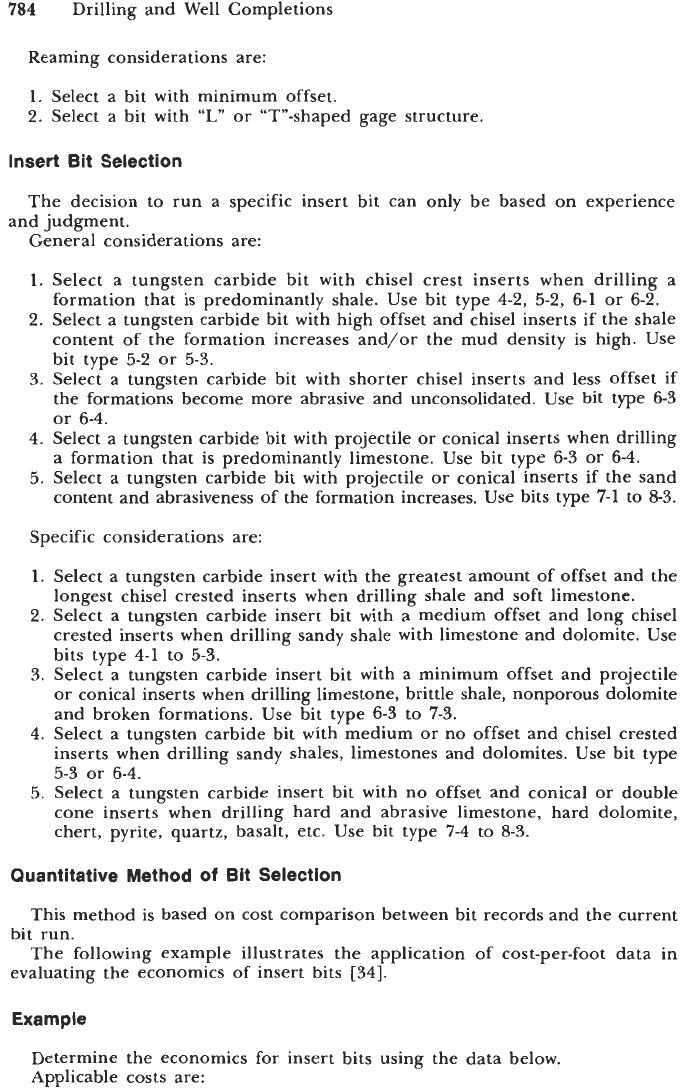
784
Drilling and Well Completions
Reaming considerations are:
1.
Select a bit with minimum offset.
2.
Select a bit with
“L”
or “T”-shaped gage structure.
Insert Bit Selection
The decision to run a specific insert bit can only be based on experience
General considerations are:
and judgment.
1.
Select a tungsten carbide bit with chisel crest inserts when drilling a
formation that is predominantly shale. Use bit type
4-2, 5-2, 6-1
or
6-2.
2.
Select
a
tungsten carbide bit with high offset and chisel inserts if the shale
content of the formation increases and/or the mud density is high. Use
bit type
5-2
or
5-3.
3.
Select a tungsten carbide bit with shorter chisel inserts and less offset if
the formations become more abrasive and unconsolidated. Use bit type
6-3
or
6-4.
4.
Select a tungsten carbide bit with projectile or conical inserts when drilling
a formation that is predominantly limestone. Use bit type
6-3
or
6-4.
5.
Select a tungsten carbide bit with projectile
or
conical inserts if the sand
content and abrasiveness of the formation increases. Use bits type
7-1
to
8-3.
Specific considerations are:
1.
Select a tungsten carbide insert with the greatest amount of offset and the
longest chisel crested inserts when drilling shale and soft limestone.
2.
Select a tungsten carbide insert bit with a medium offset and long chisel
crested inserts when drilling sandy shale with limestone and dolomite. Use
bits type
4-1
to
5-3.
3.
Select a tungsten carbide insert bit with a minimum offset and projectile
or conical inserts when drilling limestone, brittle shale, nonporous dolomite
and broken formations. Use bit type
6-3
to
7-3.
4.
Select a tungsten carbide bit with medium or no offset and chisel crested
inserts when drilling sandy shales, limestones and dolomites. Use bit type
5-3
or
6-4.
5.
Select a tungsten carbide insert bit with no offset and conical or double
cone inserts when drilling hard and abrasive limestone, hard dolomite,
chert, pyrite, quartz, basalt, etc. Use bit type
7-4
to
8-3.
Quantitative Method
of
Bit Selection
This method is based on cost comparison between bit records and the current
The following example illustrates the application of cost-per-foot data in
bit run.
evaluating the economics of insert bits
[34].
Example
Determine the economics for insert bits using the data below.
Applicable costs are:
